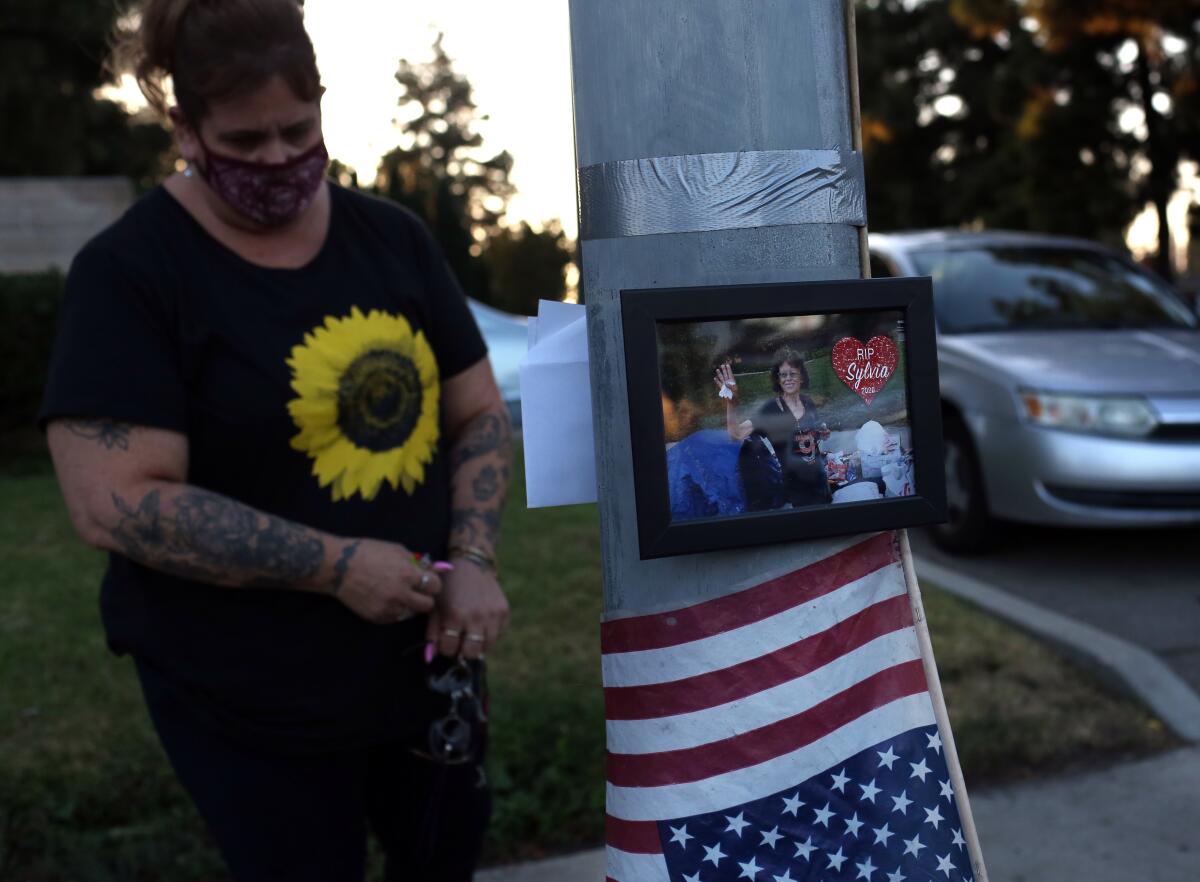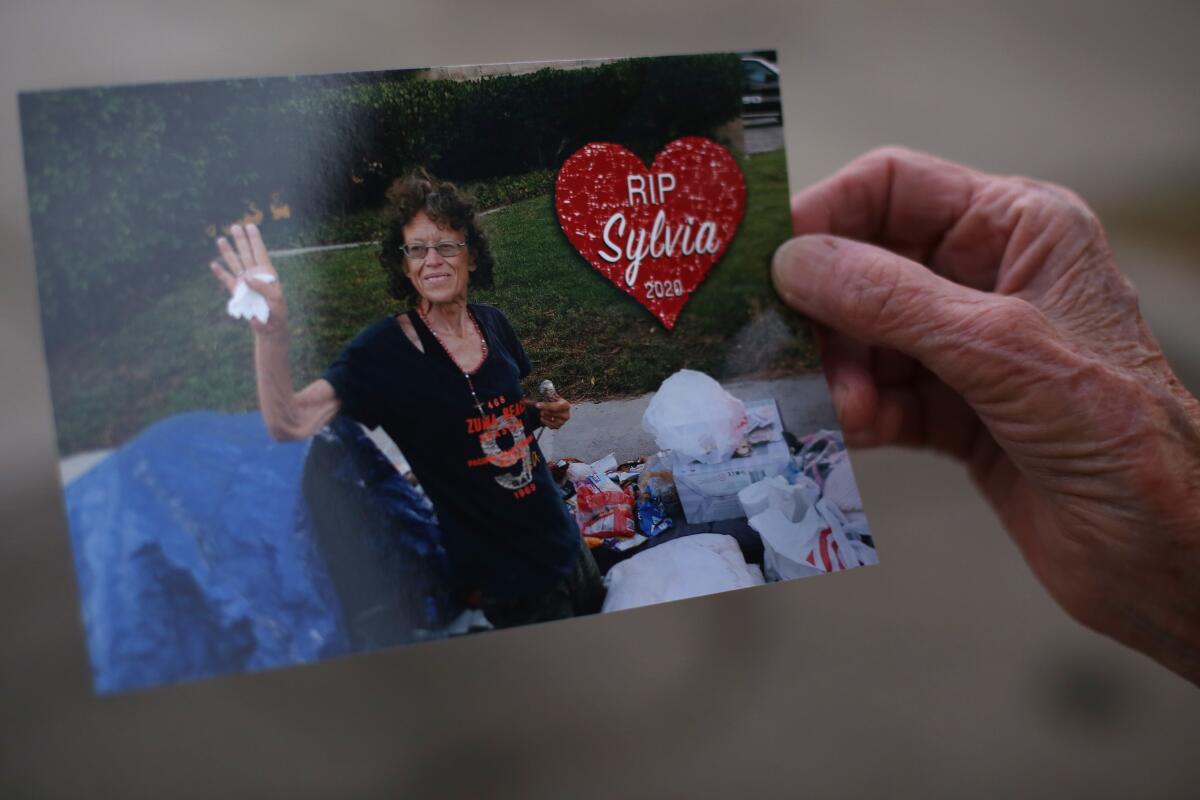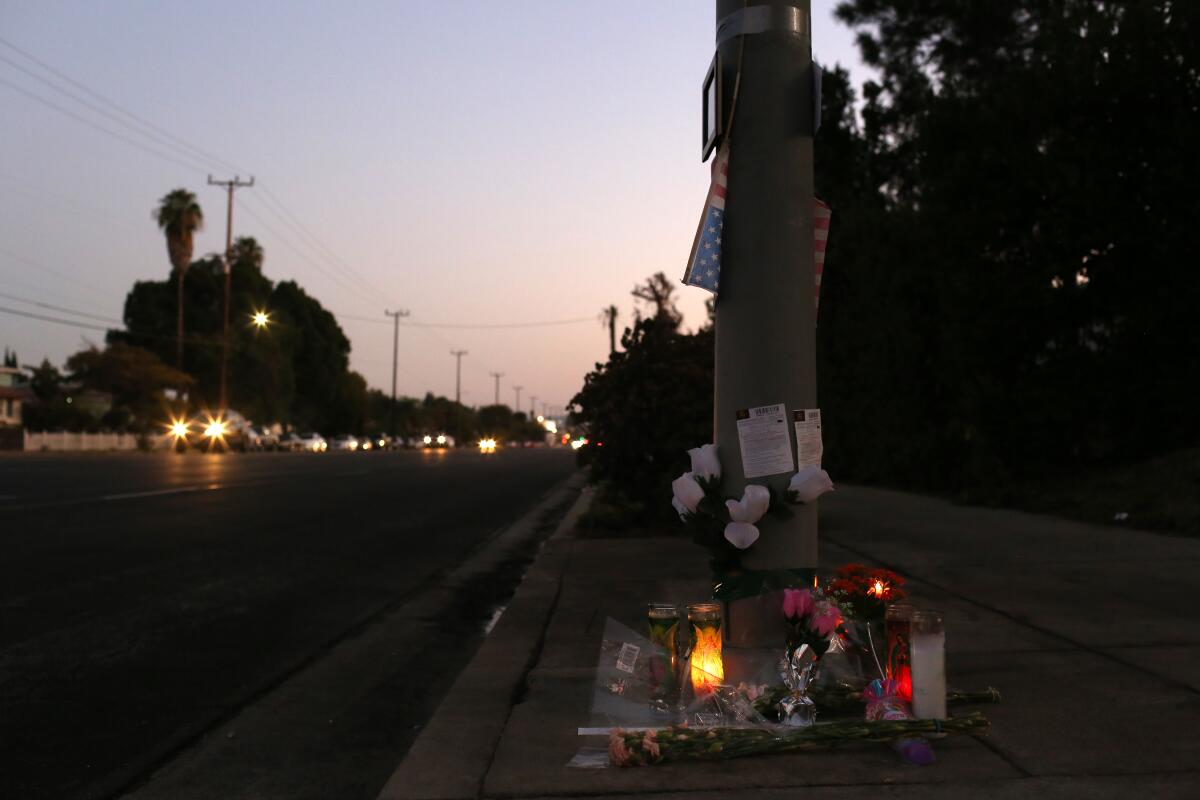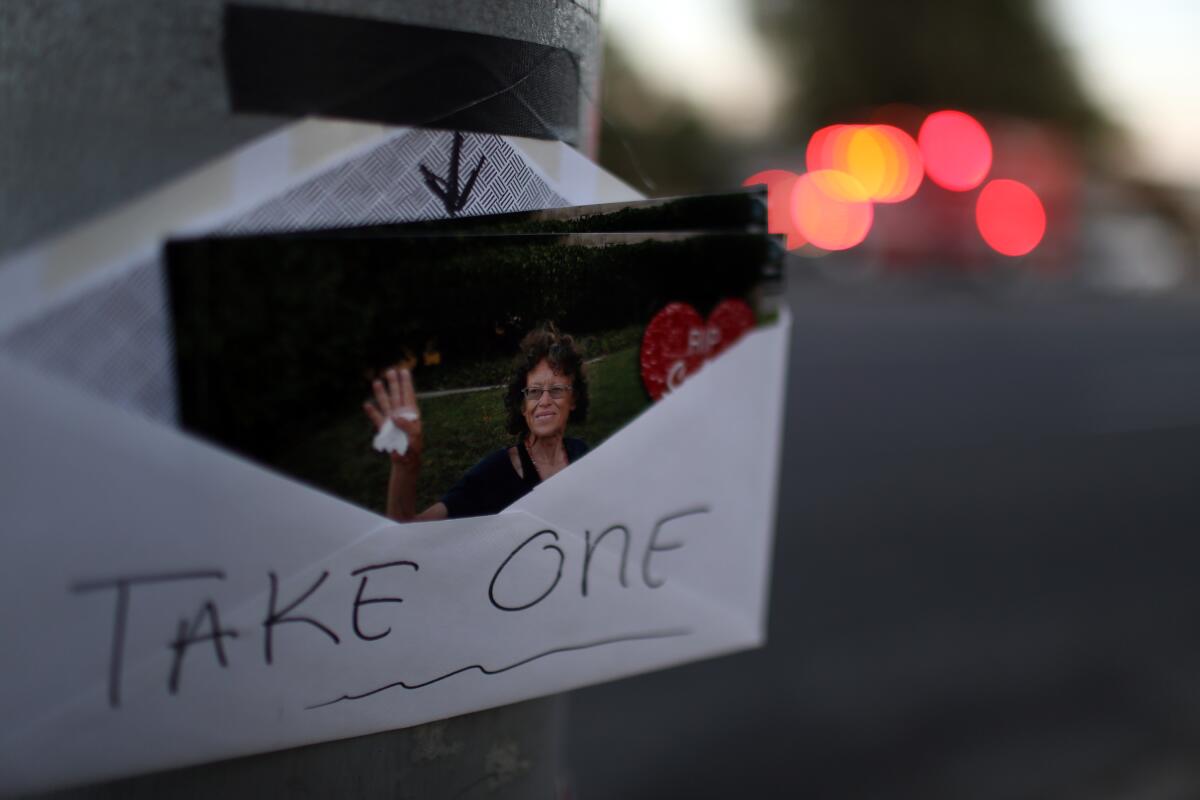She died on a sidewalk near where she grew up. She was L.A.’s 959th homeless death this year

- Share via
Sylvia Maglia, 63, was well on her way to becoming a statistic in a region where, each year, we break records for the number of people who die on our streets. She was deteriorating quickly in Granada Hills, anchored in her regular spot outside a real estate office on Balboa Boulevard, just south of San Fernando Mission Boulevard.
“She was skin and bones, and she refused to eat,” said Sandra, a homeless woman who lives on the pavement near a Target store less than a block away. “She was very sick.”
Pilar Schiavo, a Chatsworth resident who takes water and food to homeless people in the western San Fernando Valley and lobbies for more shelter beds and housing, recalls stopping to see Maglia on the wretchedly hot Labor Day weekend, when the mercury hit 118 in Granada Hills.

“One of the things that struck me about her was how very thin she was, with just bones poking out,” Schiavo said. She told me that Maglia had spilled something inside her green tent and was preoccupied with cleaning it up.
“She said thank you, and she was kind and sweet, but she had what definitely seemed like it could be some mental health issues, and she was distracted and busy with her cleaning project,” said Schiavo, who left Maglia a peanut butter and jelly sandwich and some other food and water.
Last Sunday, two weeks after that initial visit, Schiavo swung by the same spot to check on Maglia, but all she found was a shopping cart full of things she assumed were Maglia’s. Schiavo drove around looking for her, with no luck. She later learned that on Friday evening, Sept. 18, Maglia had died on the street where she had been a fixture for years.
When Maglia died, I heard from John Horn, who serves on the Granada Hills South Neighborhood Council and leads its homelessness committee.

“We can talk about ending homelessness all we want, but until we get actual housing services in our … community, then it is all just talk,” Horn said. “We have to make it known that people die on the street, even in our community…. We have to make change.”
Last year, homeless deaths in L.A. County were averaging about three a day and rapidly on their way to topping the 1,000 mark as the year closed out. When I wrote about it, on Dec. 14, the toll was at 960.
Last week, while looking into Maglia’s death, I called the county medical examiner-coroner’s office and asked where the count stood this year. I was stunned by spokeswoman Sarah Ardalani’s answer. The death toll was already at 962, and with three months left in 2020, this year’s total is sure to obliterate last year’s shameful record.
I went through the list of deaths and a few statistics jumped out. More than 80% of the victims were male. The average age of death was 48 — more than 30 years younger than the countywide average of 82.

And just as COVID-19 has hit communities of color harder, highlighting deep-seated disparities, Black people are disproportionately represented in the homeless death count. Black people represent about 9% of the county population but 26% of the deaths, at 256. The highest total by race was Hispanic/Latino, at 344, while white people accounted for 328 of the homeless deaths. Deaths occurred throughout the county, with a high concentration in and around downtown Los Angeles.
The coroner’s office and Public Health Department are analyzing the numbers for a report due in November, and with roughly a quarter of the deaths, no cause has yet been listed. Among cases that do list causes, trend lines follow those of recent years, with lots of cardiovascular disease and accompanying issues such as diabetes and liver disease, along with evidence of damage from alcohol and drugs, namely methamphetamine and opiates. Twenty homeless people died by homicide, 18 by suicide.

Dr. Paul Simon, who’s studying the numbers for the county Public Health Department, said COVID-19 appears to have been a factor in at least 44 of the deaths. But he didn’t think that either the virus or the extreme heat has been a “major driver” of the increase. Simon surmised that the high death count may largely be related to a rise in the homeless population.
“The sheer number of people living on the streets during COVID has gone up because of the economic decline and people losing their jobs and being evicted, even though there are supposed to be protections in place,” Simon said.
In Granada Hills, I caught up with Sylvia Maglia’s brother, Brent, who detailed a long history of issues with his younger sister. He said Sylvia clashed with their parents — an aeronautical engineer and a homemaker — when she was in her teens. She was later diagnosed with paranoid schizophrenia but often refused medication or treatment. Sometimes, she was aggressive enough that he feared she’d try to harm him.
He said his sister was married and divorced, often turned to drugs, and resisted many of his attempts to help.
“Long story short, it all seemed inevitable,” said Brent, who reminded me of dozens of those with homeless, mentally ill relatives I’ve spoken to over the years. They are inevitably frustrated by the lack of appropriate housing, and by the difficulty of getting professional help for someone who resists it.
Councilman John Lee, who represents Council District 12, has been criticized by some constituents for not stepping up on homeless housing. Lee, whose predecessor, Mitch Englander, could soon go to prison on corruption charges, inherited Englander’s failure to produce more housing, but he has now been in office more than a year. District 12 is one of six council districts that have not met a pledge, agreed to in March 2018, to build 222 units of supportive housing by July of this year, and the district’s meager 54 units built so far puts it in a tie for lowest in the city.
Lee told me he expects to make progress in coming weeks on a number of housing and homeless services projects, including at least one involving a state program to use motels for supportive housing.
As for Sylvia Maglia, Lee said his office has been aware of her situation — and attempts to help her — for years. Her case, he said, “sheds light on the challenge” of assisting people with a mental illness who resist help.
“Social workers from DMH have visited Sylvia probably two [or] three times a week in the last few months,” Lee said of efforts by the county Department of Mental Health.
Lee is right about the challenge, and I got a good education on that when it took me and mental health professionals roughly a year to persuade my friend Nathaniel to come inside for help. Mental illness can create doubts, fears, lack of trust — often for good reason. It can make the thought of leaving familiar surroundings, no matter how harsh, terrifying.
The key, as Lee said, is to keep going back and building trust until the No becomes a Yes. But, as I reminded the councilman, you have to have somewhere to take the person, and Los Angeles has had too few options for years.
Maglia’s brother, a retired lawyer, was frustrated about how laws designed to protect his sister’s rights might have worked against her. There is, by the way, an ongoing debate about the “grave disability” bar that must be met to force someone into help even if they refuse. In hindsight, Maglia’s life might have been saved if — given her condition and the savage heat — she had been taken to a hospital.
Instead, she died just a few blocks from the house she grew up in. Well-wishers left flowers and candles at the base of a utility pole near her spot. A UPS delivery man who used to give Maglia bottles of water when he made pickups and deliveries at a nearby Century 21 taped a note to the makeshift memorial reading “Rest in Peace,” scrawled on the back of a “Sorry we missed you” form.
A U.S. flag was wrapped around the pole, and above it someone had attached a framed photo of Maglia.
It was my first and only look at her.
In the photo, Maglia has curly hair and glasses, and she’s wearing a Zuma Beach T-shirt and a necklace with a cross pendant. She is waving to someone, maybe hello and maybe goodbye. She is smiling.
More to Read
Sign up for Essential California
The most important California stories and recommendations in your inbox every morning.
You may occasionally receive promotional content from the Los Angeles Times.














